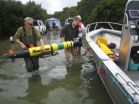(Press-News.org)
RENO, Nev. – A team of University of Nevada, Reno and University of Nevada, Las Vegas researchers have devised a new model for how Nevada's gold deposits formed, which may help in exploration efforts for new gold deposits.
The deposits, known as Carlin-type gold deposits, are characterized by extremely fine-grained nanometer-sized particles of gold adhered to pyrite over large areas that can extend to great depths. More gold has been mined from Carlin-type deposits in Nevada in the last 50 years – more than $200 billion worth at today's gold prices – than was ever mined from during the California gold rush of the 1800s.
This current Nevada gold boom started in 1961 with the discovery of the Carlin gold mine, near the town of Carlin, at a spot where the early westward-moving prospectors missed the gold because it was too fine-grained to be readily seen. Since the 1960s, geologists have found clusters of these "Carlin-type" deposits throughout northern Nevada. They constitute, after South Africa, the second largest concentration of gold on Earth. Despite their importance, geologists have argued for decades about how they formed.
"Carlin-type deposits are unique to Nevada in that they represent a perfect storm of Nevada's ideal geology – a tectonic trigger and magmatic processes, resulting in extremely efficient transport and deposition of gold," said John Muntean, a research economic geologist with the Nevada Bureau of Mines and Geology at the University of Nevada, Reno and previously an industry geologist who explored for gold in Nevada for many years.
"Understanding how these deposits formed is important because most of the deposits that cropped out at the surface have likely been found. Exploration is increasingly targeting deeper deposits. Such risky deep exploration requires expensive drilling.
"Our model for the formation of Carlin-type deposits may not directly result in new discoveries, but models for gold deposit formation play an important role in how companies explore by mitigating risk. Knowing how certain types of gold deposits form allows one to be more predictive by evaluating whether ore-forming processes operated in the right geologic settings. This could lead to identification of potential new areas of discovery."
Muntean collaborated with researchers from the University of Nevada, Las Vegas: Jean Cline, a facultyprofessor of geology at UNLV and a leading authority on Carlin-type gold deposits; Adam Simon, an assistant professor of geoscience who provided new experimental data and his expertise on the interplay between magmas and ore deposits; and Tony Longo, a post-doctoral fellow who carried out detailed microanalyses of the ore minerals.
The team combined decades of previous studies by research and industry geologists with new data of their own to reach their conclusions, which were written about in the Jan. 23 early online issue of Nature Geoscience magazine and will appear in the February printed edition. The team relates formation of the gold deposits to a change in plate tectonics and a major magma event about 40 million years ago. It is the most complete explanation for Carlin-type gold deposits to date.
"Our model won't be the final word on Carlin-type deposits," Muntean said. "We hope it spurs new research in Nevada, especially by people who may not necessarily be ore deposit geologists."
INFORMATION:
The work was funded by grants from the National Science Foundation, the United States Geological Survey, Placer Dome Exploration and Barrick Gold Corporation. The article appears in the online edition of the journal Nature Geosciences, available at http://www.nature.com/ngeo under "advanced online publication."
New model by University of Nevada for how Nevada gold deposits formed may help in gold exploration
2011-02-04
ELSE PRESS RELEASES FROM THIS DATE:
Scientists find part of New Zealand's submerged 'Pink Terraces'
2011-02-04
They were called the Eighth Wonder of the World. Until the late 19th century, New Zealand's Pink and White Terraces along Lake Rotomahana on the North Island, attracted tourists from around the world, interested in seeing the beautiful natural formations created by a large geothermal system. But the eruption of Mt. Tarawera on June 10, 1886, buried the terraces in sediment and caused the lake basin to enlarge, engulfing the land where the terraces stood. For more than a century, people have speculated whether any part of the Pink and White Terraces survived the eruption.
This ...
Brains need love, too
2011-02-04
Mom's touch and diet – Claire-Dominique Walker, PhD, director, Neuroscience Research Division, Douglas Institute.
The quality and quantity of maternal milk and maternal-infant contact impact the stress response of the adult offspring, according to recent research published in Developmental Psychobiology. "This manuscript reviews and highlights how critical factors early in life can shape the physiology and behaviour of adult offspring," says Claire-Dominique Walker, Douglas research scientist and study senior author. "For example, we have shown that, in rodent models, ...
Homeless people without enough to eat are more likely to be hospitalized
2011-02-04
Homeless people who do not get enough to eat use hospitals and emergency rooms at very high rates, according to a new study. One in four respondents to a nationwide survey reported not getting enough to eat, a proportion six times higher than in the general population, and more than two thirds of those had recently gone without eating for a whole day. The report will appear in the Journal of General Internal Medicine and has been released online.
"The study is the first to highlight the association between food insufficiency and health care use in a national sample ...
Early infusion of donor T cells prevents graft versus host disease in blood cancer patients
2011-02-04
(WASHINGTON, February 3, 2011) – For blood cancer patients at high risk of relapse, hematopoietic stem cell transplantation (HSCT), the transplantation of blood-forming stem cells, is one of best options for treatment and a potential cure. Unfortunately, the most common complication of HSCT is graft-versus-host disease (GVHD), a serious and often deadly post-transplant complication that occurs when the newly transplanted donor cells recognize the recipient's own cells as foreign and react by attacking the cells in the patient's body. A study published today in Blood, the ...
GSA supports new US call for improved nutrition and physical activity
2011-02-04
The Gerontological Society of America (GSA) — the nation's largest interdisciplinary organization devoted to the field of aging — commends the federal government's recent release of the "2010 Dietary Guidelines for Americans" and particularly applauds its inclusion of specific advice for older adults.
Because more than one-third of children and more than two-thirds of adults in the U.S. are overweight or obese, the 7th edition of "Dietary Guidelines for Americans," issued by the Department of Agriculture and the Department of Health and Human Services, places stronger ...
Wolverine population threatened by climate change
2011-02-04
BOULDER--The aggressive wolverine may not be powerful enough to survive climate change in the contiguous United States, new research concludes.
Wolverine habitat in the northwestern United States is likely to warm dramatically if society continues to emit large amounts of greenhouse gases, according to new computer model simulations carried out at the National Center for Atmospheric Research (NCAR). The study found that climate change is likely to imperil the wolverine in two ways: reducing or eliminating the springtime snow cover that wolverines rely on to protect and ...
States should extend benefits for youth in foster care, MU expert says
2011-02-04
COLUMBIA, Mo. – Each year, 29,000 foster youths are released from care as they become adults. A University of Missouri foster care expert says these young people encounter tremendous challenges as they transition out of care. However, those who receive care benefits through age 21 have greatly improved outcomes. Clark Peters, assistant professor in the School of Social Work, says all states should consider extending benefits for foster youth.
"The transition between foster care and the real world leaves many 18-year-olds without a place to stay, money, a job or reliable ...
Learning causes structural changes in affected neurons
2011-02-04
When a laboratory rat learns how to reach for and grab a food pellet – a pretty complex and unnatural act for a rodent – the acquired knowledge significantly alters the structure of the specific brain cells involved, which sprout a whopping 22 percent more dendritic spines connecting them to other motor neurons.
The finding, published in the journal Proceedings of the National Academy of Sciences by Mark H. Tuszynski, MD, PhD, professor of neurosciences and colleagues at the University of California, San Diego School of Medicine, underscores the brain's remarkable ability ...
'Tall order' sunlight-to-hydrogen system works, neutron analysis confirms
2011-02-04
OAK RIDGE, Tenn. Feb. 3, 2011 -- Researchers at the Department of Energy's Oak Ridge National Laboratory have developed a biohybrid photoconversion system -- based on the interaction of photosynthetic plant proteins with synthetic polymers -- that can convert visible light into hydrogen fuel.
Photosynthesis, the natural process carried out by plants, algae and some bacterial species, converts sunlight energy into chemical energy and sustains much of the life on earth. Researchers have long sought inspiration from photosynthesis to develop new materials to harness the ...
Loss of oyster reefs a global problem, but one with solutions
2011-02-04
(February 3, 2011) Those familiar with Chesapeake Bay know that its once-vast oyster population stands at a tiny fraction of its historical abundance. A new study by an international team including professor Mark Luckenbach of the Virginia Institute of Marine Science shows that the decline of oyster reefs is not just a local problem.
The team's global comparison of oyster reefs past and present shows that oyster reefs are at less than 10% of their prior abundance in 70% of the 144 bays studied, ranging from China to England to Australia to Brazil. Overall, they estimate ...




